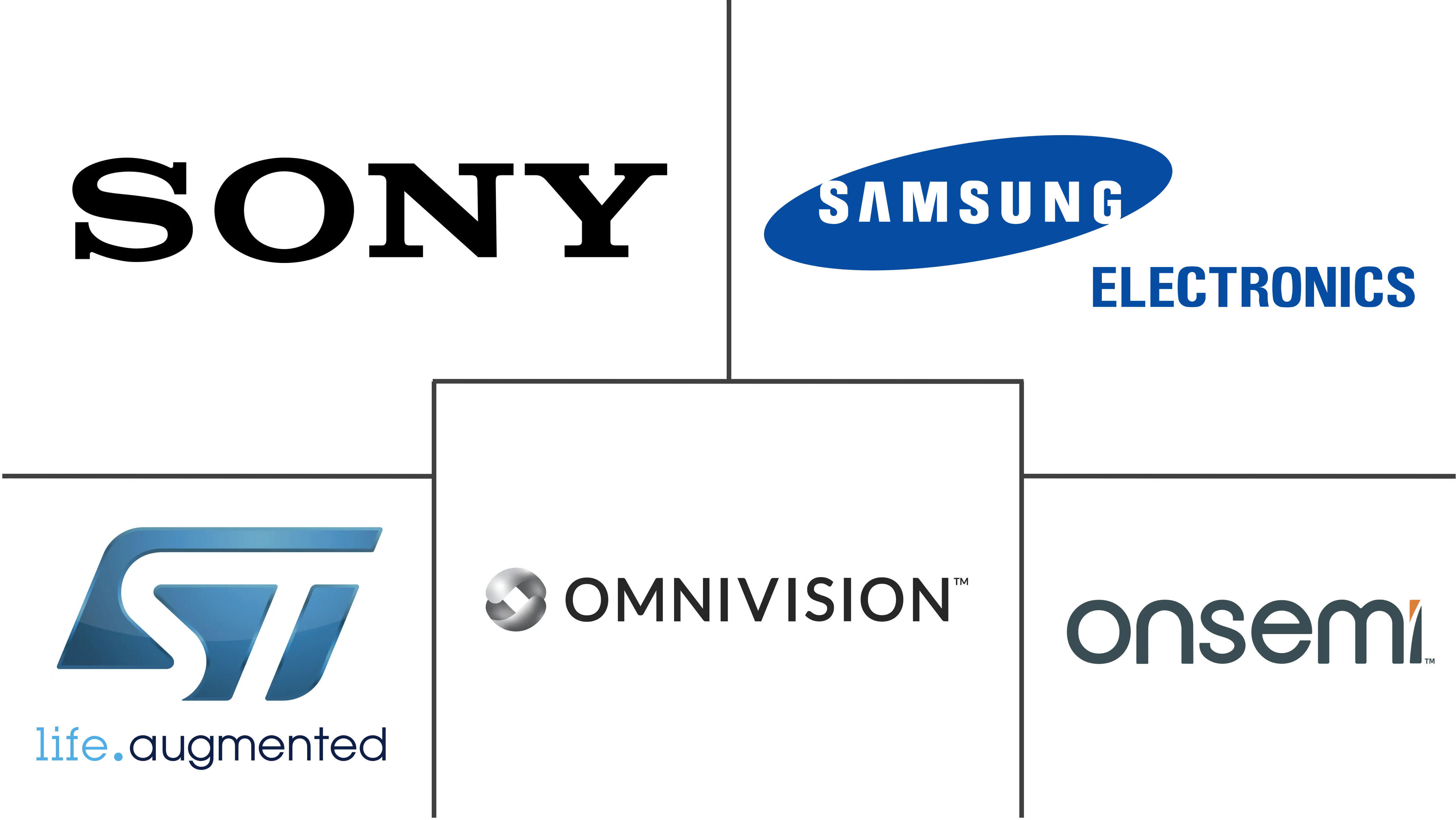CMOS Image Sensors Market Size and Share
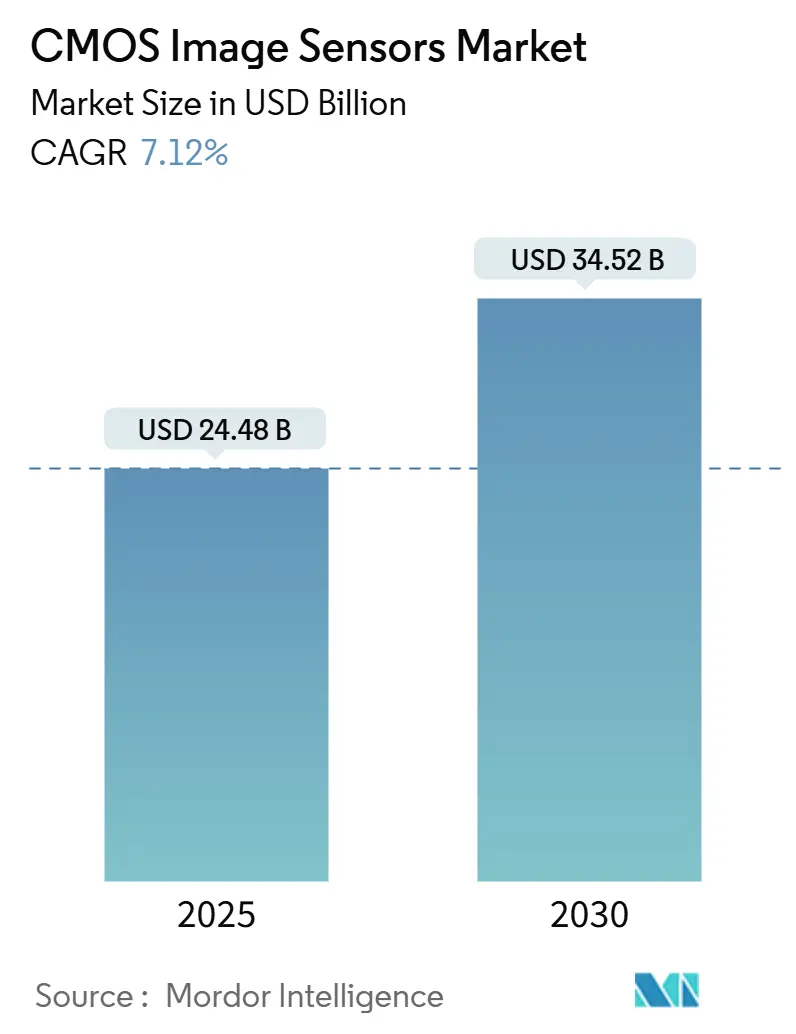
CMOS Image Sensors Market Analysis by Mordor Intelligence
The CMOS image sensor market stands at USD 24.58 billion in 2025 and is forecast to reach USD 34.52 billion by 2030, registering a 7.12% CAGR. Demand spreads from smartphone cameras to automotive safety, industrial automation and medical diagnostics, reflecting the technology’s growing functionality advantages over CCD designs. Stacked backside-illuminated (BSI) architectures incorporating on-die AI logic raise performance while trimming power budgets, reinforcing the CMOS image sensor market’s cost-leadership in mass-volume electronics. Regionally, Asia-Pacific anchors production through Taiwan’s foundries, while Middle East and Africa outpace with double-digit expansion on smart-city surveillance deployments. Consolidation continues as legacy producers divest capacity and specialist acquisitions accelerate, even as U.S.–China export controls and 300 mm wafer shortages inject supply-chain risk.
Key Report Takeaways
- By technology, BSI architecture held 65% of CMOS image sensor market share in 2024; stacked BSI/3D sensors are projected to advance at a 9.8% CAGR to 2030.
- By resolution, 12–24 MP devices accounted for 25% share of the CMOS image sensor market size in 2024, while ≥49 MP sensors are set to expand at a 9.5% CAGR through 2030.
- By spectrum, visible-light sensors dominated with 97% revenue share in 2024; non-visible devices (NIR/UV/SWIR) are growing at a 9% CAGR.
- By communication type, wired interfaces retained an 85% revenue share in 2024; wireless sensors are exhibiting an 8.1% CAGR.
- By end-user industry, consumer electronics led with 28% share of the CMOS image sensor market size in 2024, whereas automotive applications are rising at a 9.4% CAGR.
- Regionally, Asia-Pacific commanded 34% of 2024 revenue; Middle East and Africa is the fastest-growing geography at 9.8% CAGR.
- Sony, Samsung and OmniVision jointly controlled roughly 60% of global revenue in 2024, indicating a moderately concentrated landscape.
Global CMOS Image Sensors Market Trends and Insights
Drivers Impact Analysis
| DRIVER | (~) % IMPACT ON CAGR FORECAST | GEOGRAPHIC RELEVANCE | IMPACT TIMELINE |
|---|---|---|---|
| Smartphone Multi-Camera Adoption by APAC OEMs | +1.8% | APAC core, spill-over to global markets | Medium term (2-4 years) |
| Regulatory Mandates for ADAS Cameras in US & EU | +1.2% | North America & EU, expanding to APAC | Long term (≥ 4 years) |
| Video-Centric Social Media Demand for 4K/8K Sensors in North America | +0.9% | North America, expanding globally | Short term (≤ 2 years) |
| Miniaturized Sensors for Wearable Medical Imaging in Japan & EU | +0.7% | Japan & EU, selective global adoption | Medium term (2-4 years) |
| Smart-City Surveillance Roll-outs in Middle East | +0.6% | Middle East, selective emerging markets | Medium term (2-4 years) |
| Global-Shutter Demand for Industrial Automation in Germany's Industry 4.0 | +0.5% | Germany & EU, expanding to industrial hubs | Long term (≥ 4 years) |
| Source: Mordor Intelligence | |||
Smartphone Multi-Camera Adoption by APAC OEMs
APAC handset makers are extending multi-camera arrays from flagships into mid-range lines, driving sustained unit growth for high-dynamic-range image sensors. Samsung’s 2024 release of 200 MP and 50 MP ISOCELL devices underscored the pivot toward computational photography and higher frame-rate video. OmniVision’s OV50X, offering 110 dB single-exposure HDR, illustrates how premium smartphones now differentiate on sensor capability rather than megapixel count alone. Sony’s LYT-828, entering mass production in 2025, embeds Hybrid Frame-HDR logic on-die, allowing AI-assisted low-light processing without external ISP cycles. The combination of higher pixel densities and on-sensor compute supports feature expansion while raising average selling prices for advanced parts, reinforcing revenue growth for the CMOS image sensor market.[1]Samsung Electronics, “Samsung Unveils Versatile Image Sensors for Superior Smartphone Photography,” news.samsung.com
Regulatory Mandates for ADAS Cameras in US & EU
NHTSA’s December 2024 New Car Assessment Program upgrade mandates camera-based blind-spot, lane-keeping and automatic emergency-braking systems across light vehicles, anchoring long-term sensor demand. Global-shutter architectures mitigate motion artifacts essential for safety-critical imaging, evident in Subaru’s next-generation EyeSight system that selects onsemi’s Hyperlux AR0823AT sensor meeting ASIL C safety standards. The EU’s General Safety Regulation mirrors U.S. requirements, synchronizing specifications and giving CMOS foundry operators visibility for a decade of automotive-grade capacity investments.[2]DPReview Staff, “New smartphone image sensor promises the highest dynamic range available,” dpreview.com
Video-Centric Social-Media Demand for 4K/8K Sensors in North America
Content creators prioritizing vertical 4K and 8K formats for platforms such as YouTube and TikTok require sensors delivering low-latency readout at reduced rolling-shutter distortion. Prophesee’s Metavision deblur engine tailored for Snapdragon 8 Gen 3 chipsets offers event-driven processing that attenuates motion blur in handheld shooting, highlighting new algorithm-sensor co-design approaches. The social-media feedback loop accelerates replacement cycles, reinforcing premium demand inside the CMOS image sensor market.
Miniaturized Sensors for Wearable Medical Imaging in Japan & EU
Japan’s aging demographics and EU healthcare cost-containment policies advance adoption of wearable diagnostics featuring implantable CMOS multi-ion sensors for brain chemistry monitoring. Sensor miniaturization combined with on-die analytics lowers power draw, enabling always-on health tracking with local data processing to preserve privacy. Smart-glasses prototypes achieve 1° eye-tracking accuracy, evidencing how medical and human-machine-interface functions converge on CMOS platforms.
Restraints Impact Analysis
| RESTRAINTS | (~) % IMPACT ON CAGR FORECAST | GEOGRAPHIC RELEVANCE | IMPACT TIMELINE |
|---|---|---|---|
| Advanced 300-mm CIS Wafer Capacity Constraints in Taiwan & Korea | -1.4% | Global, concentrated in APAC supply chain | Short term (≤ 2 years) |
| ASP Erosion in Entry-Level Smartphones | -0.8% | Global, most pronounced in emerging markets | Medium term (2-4 years) |
| Thermal Noise & Rolling-Shutter Limits in High-Speed Cinematography | -0.5% | Global, specialized applications | Long term (≥ 4 years) |
| US-China Export Controls on Leading-Edge CIS | -0.9% | Global, supply chain fragmentation | Medium term (2-4 years) |
| Source: Mordor Intelligence | |||
Advanced 300 mm CIS Wafer Capacity Constraints in Taiwan & Korea
Surging AI-chip orders compete with image-sensor output for advanced 300 mm lines at Taiwanese and Korean foundries, extending lead times from 12–16 weeks to 20–24 weeks. TSMC’s Arizona expansion, though capitalized at USD 165 billion, will not meaningfully relieve CIS bottlenecks before 2027. The geographic clustering of stacked BSI manufacturing heightens geopolitical exposure, significantly tempering near-term supply elasticity for the CMOS image sensor market.
ASP Erosion in Entry-Level Smartphones
Commodity-grade cameras in budget smartphones suffer falling average selling prices as reference designs proliferate. Chinese vendor SmartSens attracted USD 225 million to compete aggressively on price, intensifying margin compression across volume tiers. Established producers therefore pivot resources to automotive and industrial niches where differentiated performance sustains healthier margins.
Segment Analysis
By Technology: BSI Architecture Extends Performance Frontier
Backside-illuminated sensors captured 65% CMOS image sensor market share in 2024, reflecting superior sensitivity and higher signal-to-noise ratios. The segment’s ascendancy lifted the BSI-based CMOS image sensor market size for premium smartphones and automotive cameras. Stacked BSI/3D sensors are advancing at 9.8% CAGR, integrating logic layers that execute AI inference in situ and further enlarge value per square millimeter.
Front-side-illuminated devices maintain relevance in cost-constrained SKUs such as entry-level IoT cameras. Global-shutter architectures, often FSI-based, gain adoption in industrial automation to thwart motion artefacts. Emerging glass-substrate 3D stacking, projected between 2026 and 2030, promises tighter thermal profiles and higher interconnect densities, widening high-end differentiation.[3]Photonics Media, “Definition of backside-illuminated sensor,” photonics.com
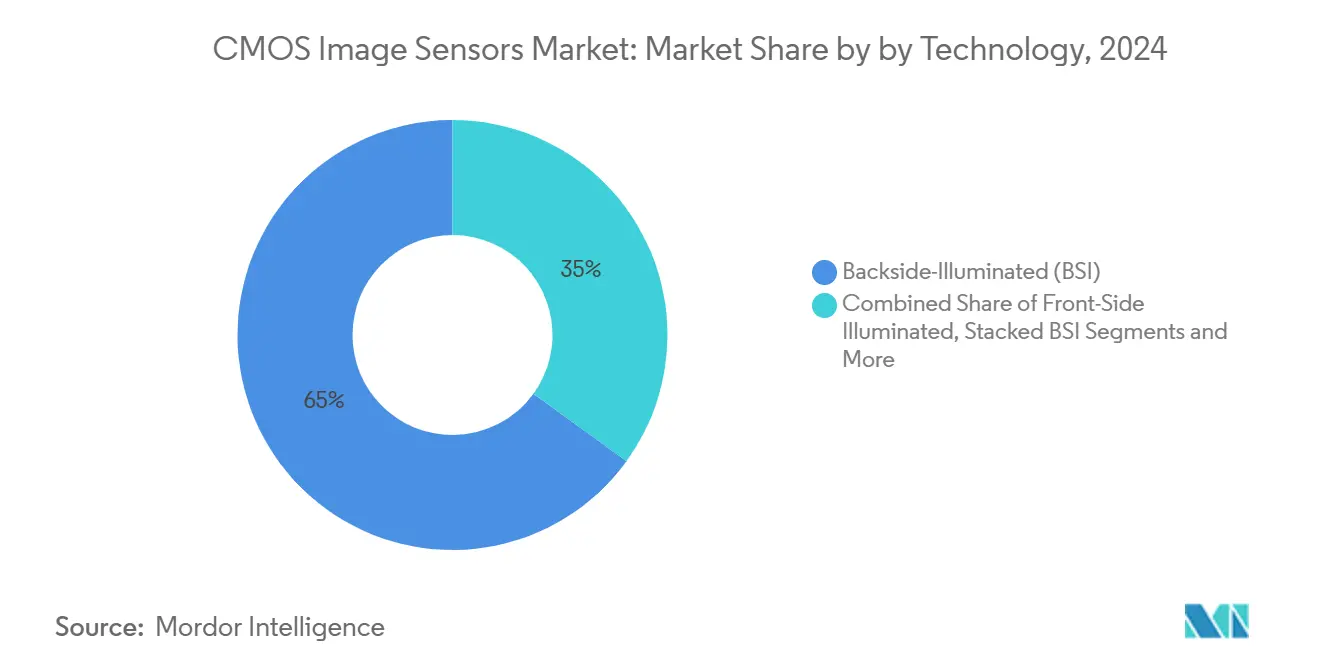
Note: Segment shares of all individual segments available upon report purchase
By Resolution: Ultra-High Pixel Counts Address Niche Demands
The 12–24 MP band accounted for 25% CMOS image sensor market share in 2024, balancing storage and compute overhead in mainstream handsets. ≥49 MP devices, though niche, are growing 9.5% annually as surveillance, medical and professional photography favor extreme digital zoom. Canon’s 410 MP prototype highlights technical viability of full-frame ultra-high-density sensors, potentially catalyzing new diagnostic imaging modalities.
Sub-12 MP parts endure in barcode scanning and dashcams where frame rate trumps definition. Mid-tier 25–48 MP sensors serve mirrorless cameras leveraging multi-frame computational overlays. The pixel-count bifurcation sharpens price segmentation across the CMOS image sensor market, preserving margin tiers.
By Spectrum: Non-Visible Bands Unlock Industrial Insight
Visible-light devices generated 97% of 2024 revenue, mirroring dominance in consumer imaging. Yet the CMOS image sensor market size for non-visible segments (NIR, UV, SWIR) is climbing at 9% CAGR as manufacturing, agriculture and security adopt wavelength-specific analytics. UV and SWIR cameras expose contamination and sub-surface defects that visible light misses, transforming quality-control paradigms.
Near-infrared sensors underpin biometric authentication and vital-sign monitors, linking health-tech and consumer devices. Multispectral arrays that co-capture visible and SWIR frames reduce sensor count in autonomous-vehicle perception stacks, illustrating cross-domain synergies.
By Communication Type: Wireless Links Expand Deployment Reach
Wired sensors sustained an 85% revenue share in 2024, indispensable where deterministic latency governs machine response. Wireless interfaces, however, are growing at an 8.1% CAGR as edge-processed imagery cuts bandwidth needs. 5G URLLC enables remote robotics and infrastructure monitoring once tethered by Ethernet.
Energy-harvesting modules coupled with sub-1 mW idle power broaden deployment in environmental sensing. As protocol stacks mature, the CMOS image sensor market will integrate BLE, Wi-Fi 6 and UWB radios into miniaturized optical nodes, lowering installation cost barriers.
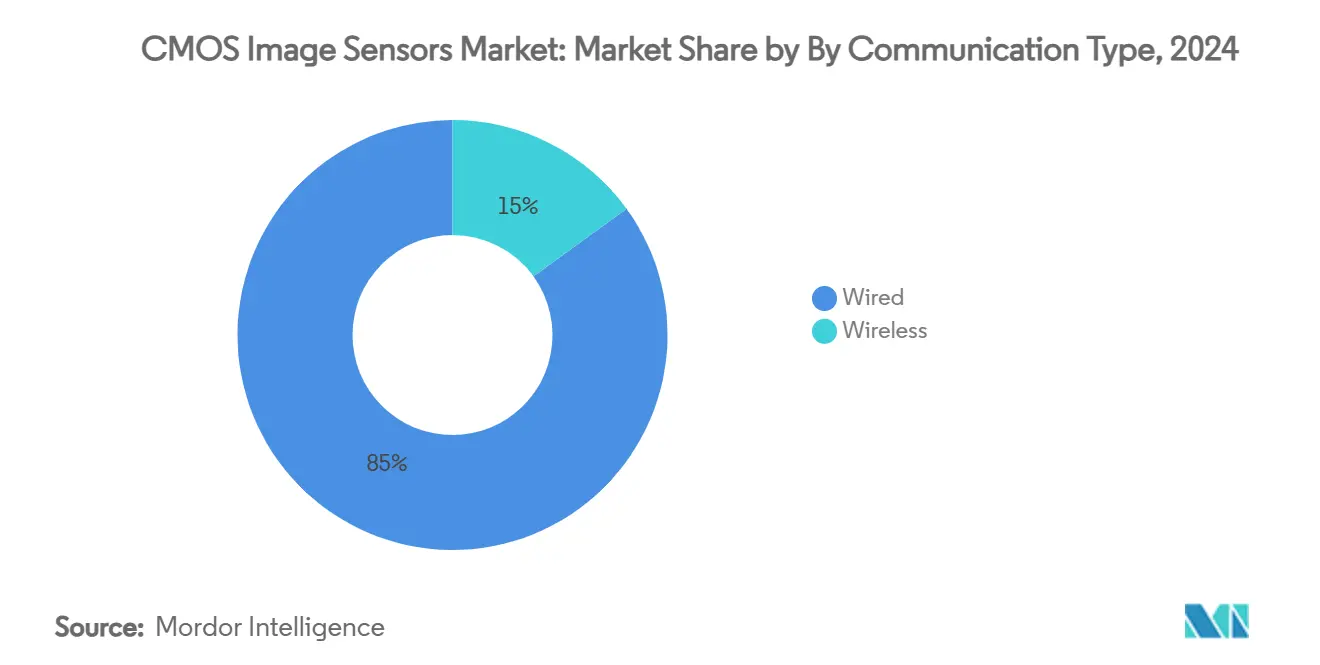
By End-User Industry: Automotive Safety Catalyzes Innovation
Consumer electronics retained 28% revenue in 2024, but automotive demand is the growth engine, climbing 9.4% CAGR on ADAS legislation convergence. Multi-camera suites per vehicle multiply sensor content, while in-cabin monitoring opens incremental volume layers.
Industrial machine vision is driving adoption of global-shutter sensors in robotic quality-control lines. Healthcare wearables leverage sub-µW idle power sensors for continuous diagnostics. Aerospace and defense require radiation-hardened imagers, yielding specialized but profitable contracts. Collectively, diversified verticals temper cyclicality in the CMOS image sensor industry.
Geography Analysis
Asia-Pacific holds 34% of 2024 revenue, benefiting from vertically integrated ecosystems spanning foundry silicon to final handset assembly. Taiwanese fabs supply the bulk of stacked-BSI wafers, while mainland China remains the world’s largest smartphone export base. Korean innovation, led by Samsung’s ISOCELL roadmap, sustains technology leadership inside the CMOS image sensor market. Supply-chain concentration confers scale economics yet elevates earthquake and geopolitical exposure.
Middle East and Africa present the fastest growth at 9.8% CAGR to 2030 as Gulf smart-city blueprints demand networked surveillance and traffic-analytics cameras. ADAS-equipped vehicle imports lift aftermarket replacement cycles, while Africa’s mobile-first e-commerce boom drives low-light selfie camera volumes. Public-private funding incentives accelerate local system integration, creating an emerging corridor for CMOS image sensor market expansion.
North America influences global design through social-media platform demands and stringent automotive safety rules. Content-creator ecosystems prioritize sensors optimized for high-frame-rate 8K capture, pushing domestic fabless vendors toward premium niches. Europe, anchored by Germany’s Industry 4.0 investments, channels photonics R&D into high-reliability industrial and medical segments. South America and South Asia represent untapped volume, though price sensitivity steers procurement toward established mid-tier designs rather than bleeding-edge sensors.
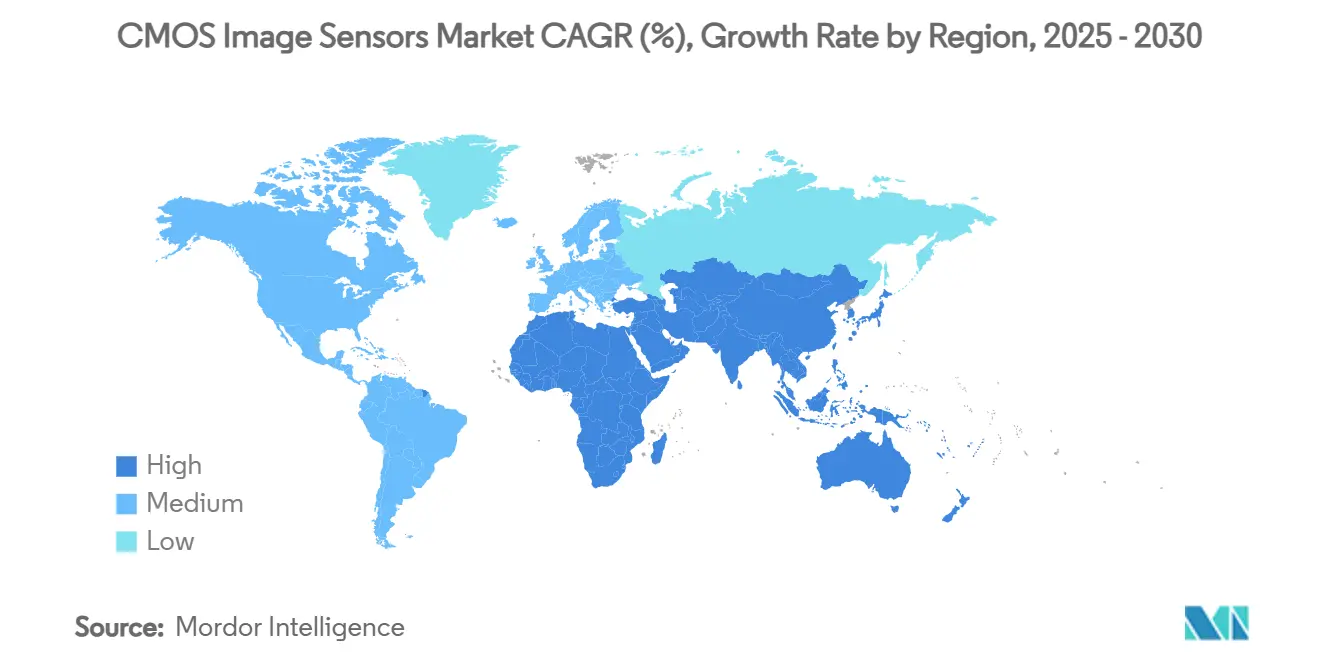
Competitive Landscape
Sony, Samsung and OmniVision collectively command roughly 60% of global revenue, giving the CMOS image sensor market a moderate concentration profile. Sony exploits proprietary stacked BSI processes to lead premium performance brackets, Samsung scales advanced pixel architectures on internal 300 mm lines, and OmniVision differentiates through cost-efficient automotive and IoT portfolios.
Strategic realignment is reshaping the field. SK Hynix is curtailing CIS output to reallocate capex toward high-bandwidth memory, vacating share for aggressive Chinese challengers. Hamamatsu’s 2024 acquisition of BAE Systems Imaging Solutions augments North American design talent for high-performance scientific sensors. Event-based pioneer Prophesee and thermal specialist Meridian Innovation illustrate how niche players penetrate by solving application-specific pain points.
Supply-chain fragility remains a strategic risk. U.S. export restrictions impede Chinese access to EUV equipment, potentially bifurcating technology roadmaps. Foundry capacity scarcity positions integrated device manufacturers with captive fabs—such as Sony and Samsung—to weather allocation shocks better than pure-play fabless brands. Intellectual-property barriers around stacked BSI and on-die AI processing consolidate competitive moats despite new-entrant funding.
CMOS Image Sensors Industry Leaders
-
Sony Group Corporation
-
Samsung Electronics Co., Ltd.
-
OmniVision Technologies, Inc.
-
onsemi Corporation
-
STMicroelectronics N.V.
- *Disclaimer: Major Players sorted in no particular order
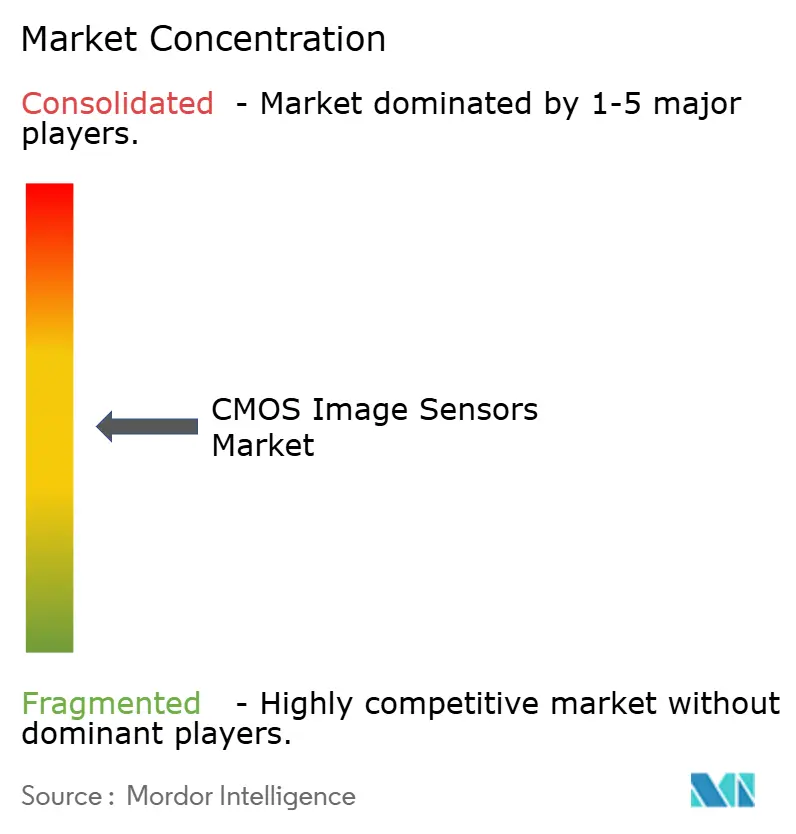
Recent Industry Developments
- June 2025: Sony Semiconductor Solutions announced the LYT-828, a 50-megapixel CMOS image sensor featuring dynamic range exceeding 100 dB and Hybrid Frame-HDR technology, scheduled for mass production in late August 2025 to enhance smartphone imaging capabilities in high-contrast scenes.
- April 2025: OmniVision launched a 1.5-megapixel global shutter sensor specifically designed for automotive driver monitoring systems, expanding the company's presence in automotive safety applications.
- April 2025: TSMC's Arizona facility accelerated expansion plans with a USD 165 billion investment to house six fabs, with the first fab utilizing 4nm technology for high-end SoCs and subsequent fabs planned for 3nm and 2nm technologies.
- March 2025: onsemi introduced the Hyperlux ID family, the first real-time indirect time-of-flight sensor capable of high precision depth measurements up to 30 meters for industrial automation applications.
Global CMOS Image Sensors Market Report Scope
A complementary metal-oxide-semiconductor(CMOS) image sensor is an optical technology used in machine vision for robots in OCR (optical character recognition) that can enhance satellite photographs and radar images. It is also used in digital cameras, CCTV cameras, and barcode readers.
The report's scope encompasses market sizing and forecast for communication type, end-user industry, and geography segments. By communication type, the market is segmented into wired and wireless. By end-user industry, the market is segmented into consumer electronics, healthcare, industrial, security and surveillance, automotive and transportation, aerospace and defense, and computing. By geography, the market is segmented into North America, Europe, Asia Pacific, Latin America, the Middle East, and Africa.
The report offers market forecasts and size in volume (units) and value (USD) for all the above segments.
| Front-Side Illuminated (FSI) |
| Backside-Illuminated (BSI) |
| Stacked BSI / 3-D |
| Global-Shutter CMOS |
| Less than 12 Megapixels |
| 12-24 Megapixels |
| 25-48 Megapixels |
| Greater than 49 Megapixels |
| Visible Spectrum |
| Non-Visible (NIR, UV, SWIR) Spectrum |
| Wired |
| Wireless |
| Consumer Electronics |
| Automotive and Transportation |
| Industrial and Machine Vision |
| Security and Surveillance |
| Healthcare and Life Sciences |
| Computing and Data-center |
| Aerospace and Defense |
| North America | United States |
| Canada | |
| Mexico | |
| Europe | United Kingdom |
| Germany | |
| France | |
| Italy | |
| Rest of Europe | |
| Asia-Pacific | China |
| Japan | |
| India | |
| South Korea | |
| Rest of Asia-Pacific | |
| Middle East | Israel |
| Saudi Arabia | |
| United Arab Emirates | |
| Turkey | |
| Rest of Middle East | |
| Africa | South Africa |
| Egypt | |
| Rest of Africa | |
| South America | Brazil |
| Argentina | |
| Rest of South America |
| By Technology | Front-Side Illuminated (FSI) | |
| Backside-Illuminated (BSI) | ||
| Stacked BSI / 3-D | ||
| Global-Shutter CMOS | ||
| By Resolution | Less than 12 Megapixels | |
| 12-24 Megapixels | ||
| 25-48 Megapixels | ||
| Greater than 49 Megapixels | ||
| By Spectrum | Visible Spectrum | |
| Non-Visible (NIR, UV, SWIR) Spectrum | ||
| By Communication Type | Wired | |
| Wireless | ||
| By End-user Industry | Consumer Electronics | |
| Automotive and Transportation | ||
| Industrial and Machine Vision | ||
| Security and Surveillance | ||
| Healthcare and Life Sciences | ||
| Computing and Data-center | ||
| Aerospace and Defense | ||
| By Geography | North America | United States |
| Canada | ||
| Mexico | ||
| Europe | United Kingdom | |
| Germany | ||
| France | ||
| Italy | ||
| Rest of Europe | ||
| Asia-Pacific | China | |
| Japan | ||
| India | ||
| South Korea | ||
| Rest of Asia-Pacific | ||
| Middle East | Israel | |
| Saudi Arabia | ||
| United Arab Emirates | ||
| Turkey | ||
| Rest of Middle East | ||
| Africa | South Africa | |
| Egypt | ||
| Rest of Africa | ||
| South America | Brazil | |
| Argentina | ||
| Rest of South America | ||
Key Questions Answered in the Report
What is the current CMOS image sensor market size in 2025?
The market is valued at USD 24.58 billion in 2025.
How fast will the CMOS image sensor market grow by 2030?
It is projected to reach USD 34.52 billion, reflecting a 7.12% CAGR.
Which technology segment leads the CMOS image sensor market share?
Backside-illuminated sensors hold 65% share as of 2024.
Why are automotive applications gaining importance?
Regulatory mandates in the US and EU require camera-based ADAS, driving a 9.4% CAGR for automotive sensors.
Which region is expanding the quickest?
Middle East and Africa show the highest growth at 9.8% CAGR through 2030, driven by smart-city surveillance.
How concentrated is the competitive landscape?
Sony, Samsung and OmniVision control about 60% of global sales, giving the market a moderate concentration level.
Page last updated on:
